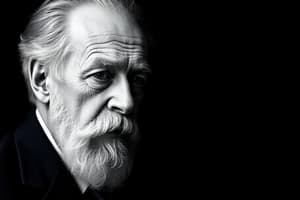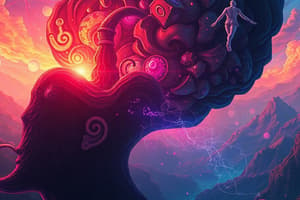Podcast
Questions and Answers
According to Freud, what is the primary role of anxiety in the context of repressed experiences?
According to Freud, what is the primary role of anxiety in the context of repressed experiences?
- It enhances the clarity and accuracy of memories, making them more accessible.
- It serves as a signal to seek immediate gratification of unconscious desires.
- It stimulates repression, forcing unwanted experiences into the unconscious as a defense. (correct)
- It directly manifests as traumatic memories in the conscious mind.
How did Freud propose that the existence of the unconscious could be demonstrated?
How did Freud propose that the existence of the unconscious could be demonstrated?
- By directly questioning individuals about their unconscious thoughts.
- By analyzing its influence on dreams, slips of the tongue and instances of forgetting. (correct)
- Through direct observation of unconscious processes.
- Through advanced neuroimaging techniques.
What is the role of 'censorship' in Freud's model of the unconscious?
What is the role of 'censorship' in Freud's model of the unconscious?
- To regulate the flow of information within the conscious mind.
- To facilitate direct communication between the conscious and unconscious mind.
- To ensure the accurate recall of childhood memories.
- To block threatening memories from entering awareness by disguising or distorting them. (correct)
How did Freud differentiate his concept of phylogenetic endowment from Carl Jung's idea of the collective unconscious?
How did Freud differentiate his concept of phylogenetic endowment from Carl Jung's idea of the collective unconscious?
According to Freud, what are the characteristics of unconscious drives when they appear in consciousness?
According to Freud, what are the characteristics of unconscious drives when they appear in consciousness?
In Freudian psychology, what are the defined levels of mental life?
In Freudian psychology, what are the defined levels of mental life?
Which of the following best describes Freud's concept of the 'unconscious'?
Which of the following best describes Freud's concept of the 'unconscious'?
According to Freud, what might be the underlying motivation when a person teases or jokes with another?
According to Freud, what might be the underlying motivation when a person teases or jokes with another?
What did Freud mean by the unconscious mind of one person being able to 'communicate' with the unconscious of another?
What did Freud mean by the unconscious mind of one person being able to 'communicate' with the unconscious of another?
According to Freud, what happens to unconscious ideas that succeed in becoming conscious?
According to Freud, what happens to unconscious ideas that succeed in becoming conscious?
Flashcards
Unconscious (Freud)
Unconscious (Freud)
Drives, urges, or instincts beyond our awareness that motivate our words, feelings, and actions.
Repression (Freud)
Repression (Freud)
A defense mechanism where unwanted experiences are forced into the unconscious as protection from pain.
Phylogenetic Endowment
Phylogenetic Endowment
Inherited unconscious images passed down through generations.
Levels of Mental Life
Levels of Mental Life
Signup and view all the flashcards
Transformation (Freud)
Transformation (Freud)
Signup and view all the flashcards
Censorship (Freud)
Censorship (Freud)
Signup and view all the flashcards
Study Notes
- Freud's exploration of the unconscious is his greatest contribution to personality theory.
- Freud insisted that people are primarily motivated by drives with little to no awareness.
- Mental life is divided into the unconscious and the conscious.
- The unconscious has two levels: the unconscious proper and the preconscious.
- The three levels of mental life are used to designate both a process and a location in Freudian psychology.
- The existence of a specific location is hypothetical, without real existence within the body.
- Freud spoke of the unconscious, as well as unconscious processes.
Unconscious
- The unconscious contains drives, urges, or instincts beyond our awareness that motivate most of our words, feelings, and actions.
- People may be unaware of the mental processes behind their overt behaviors.
- The unconscious is not available to the conscious mind.
- Freud believed that the unconscious's existence could be proved indirectly.
- The unconscious explains the meaning behind dreams, slips of the tongue, and repression (forgetting).
- Dreams are a rich source of unconscious material.
- Freud believed childhood experiences could appear in adult dreams without conscious recollection.
- Unconscious processes often enter consciousness after being disguised or distorted to elude censorship.
- Freud used the analogy of a guardian censoring passage between the unconscious and preconscious to prevent anxiety-producing memories from entering awareness.
- Unconscious images must be disguised to pass the primary censor to enter the conscious level.
- A final censor watches the passageway between the preconscious and the conscious.
- Memories entering the conscious mind are seen as relatively pleasant, non-threatening experiences.
- Images often have strong sexual or aggressive motifs, as childhood sexual and aggressive behaviors are frequently punished or suppressed.
- Punishment and suppression create anxiety, which stimulates repression, forcing unwanted experiences into the unconscious as a defense against pain.
- A portion of our unconscious originates from ancestors' experiences passed down through generations of repetition.
- Freud called these inherited unconscious images phylogenetic endowment.
- Freud's phylogenetic endowment is similar to Carl Jung's collective unconscious.
- Jung emphasized the collective unconscious.
- Freud relied on inherited dispositions as a last resort.
- Freud turned to collectively inherited experiences to fill individual experience gaps when explanations built on individual experiences were inadequate.
- Freud used phylogenetic endowment to explain concepts like the Oedipus complex and castration anxiety.
- Unconscious drives appear in consciousness only after transformations.
- A person may express either erotic or hostile urges by teasing or joking.
- The original drive (sex or aggression) remains disguised and hidden.
- The unconscious of the first person directly influences the unconscious of the second.
- Both people gain some satisfaction of sexual or aggressive urges, but are not conscious of the motive behind the teasing or joking.
- The unconscious mind of one person can communicate with the unconscious of another without either person being aware.
- The unconscious does not mean inactive or dormant.
- Forces in the unconscious constantly strive to become conscious, even in altered forms.
- Unconscious ideas motivate people.
- A son's hostility toward his father may appear as ostentatious affection.
Studying That Suits You
Use AI to generate personalized quizzes and flashcards to suit your learning preferences.




